MERCEDES-BENZ C-Class 2000 W202 Owner's Guide
Manufacturer: MERCEDES-BENZ, Model Year: 2000, Model line: C-Class, Model: MERCEDES-BENZ C-Class 2000 W202Pages: 130, PDF Size: 2.43 MB
Page 31 of 130
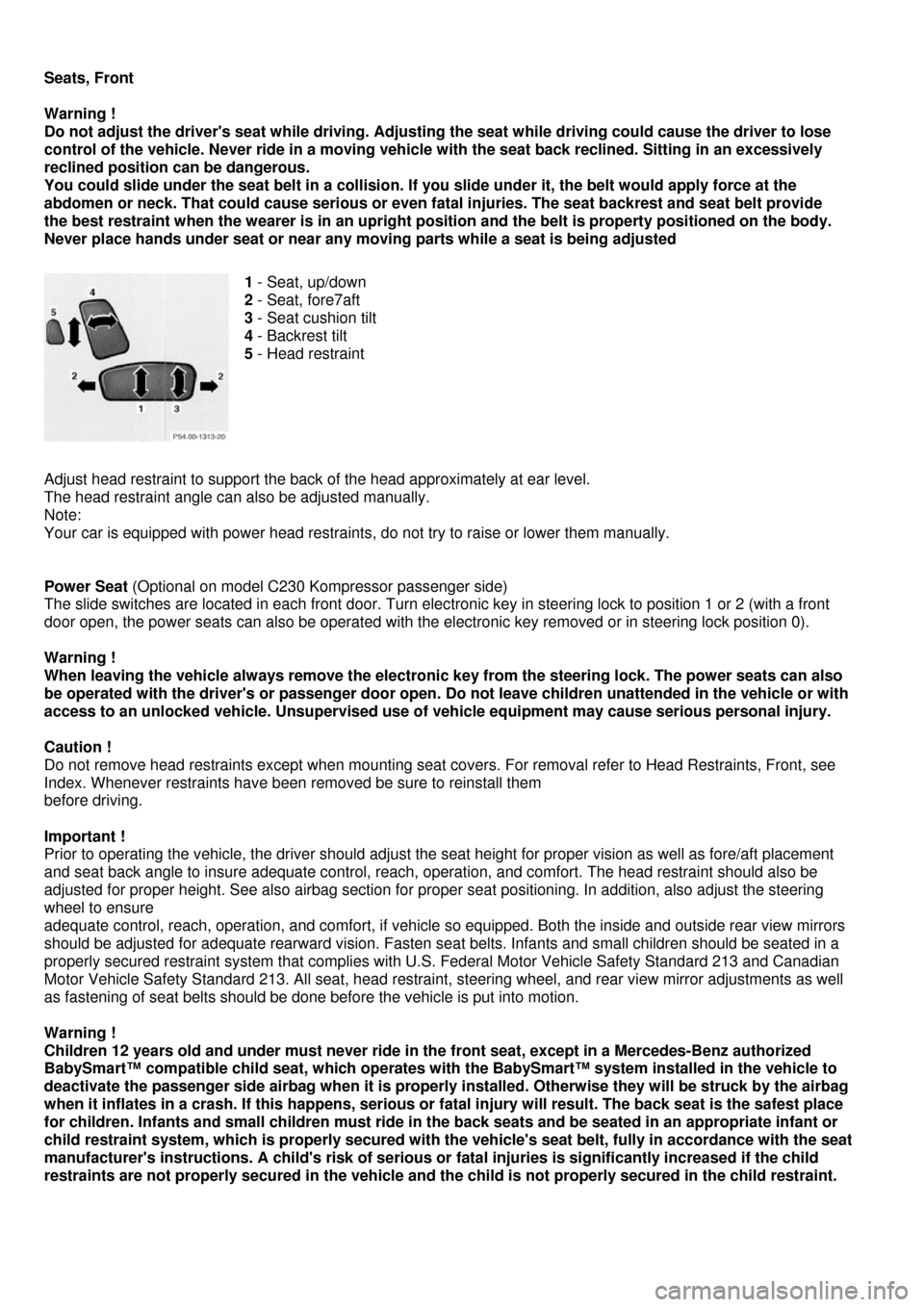
Seats, Front
Warning !
Do not adjust the driver's seat while driving. Adjusting the seat while driving could cause the driver to lose
control of the vehicle. Never ride in a moving vehicle with the seat back reclined. Sitting in an excessively
reclined position can be dangerous.
You could slide under the seat belt in a collision. If you slide under it, the belt would apply force at the
abdomen or neck. That could cause serious or even fatal injuries. The seat backrest and seat belt provide
the best restraint when the wearer is in an upright position and the belt is property positioned on the body.
Never place hands under seat or near any moving parts while a seat is being adjusted
1 - Seat, up/down
2 - Seat, fore7aft
3 - Seat cushion tilt
4 - Backrest tilt
5 - Head restraint
Adjust head restraint to support the back of the head approximately at ear level.
The head restraint angle can also be adjusted manually.
Note:
Your car is equipped with power head restraints, do not try to raise or lower them manually.
Power Seat (Optional on model C230 Kompressor passenger side)
The slide switches are located in each front door. Turn electronic key in steering lock to position 1 or 2 (with a front
door open, the power seats can also be operated with the electronic key removed or in steering lock position 0).
Warning !
When leaving the vehicle always remove the electronic key from the steering lock. The power seats can also
be operated with the driver's or passenger door open. Do not leave children unattended in the vehicle or with
access to an unlocked vehicle. Unsupervised use of vehicle equipment may cause serious personal injury.
Caution !
Do not remove head restraints except when mounting seat covers. For removal refer to Head Restraints, Front, see
Index. Whenever restraints have been removed be sure to reinstall them
before driving.
Important !
Prior to operating the vehicle, the driver should adjust the seat height for proper vision as well as fore/aft placement
and seat back angle to insure adequate control, reach, operation, and comfort. The head restraint should also be
adjusted for proper height. See also airbag section for proper seat positioning. In addition, also adjust the steering
wheel to ensure
adequate control, reach, operation, and comfort, if vehicle so equipped. Both the inside and outside rear view mirrors
should be adjusted for adequate rearward vision. Fasten seat belts. Infants and small children should be seated in a
properly secured restraint system that complies with U.S. Federal Motor Vehicle Safety Standard 213 and Canadian
Motor Vehicle Safety Standard 213. All seat, head restraint, steering wheel, and rear view mirror adjustments as well
as fastening of seat belts should be done before the vehicle is put into motion.
Warning !
Children 12 years old and under must never ride in the front seat, except in a Mercedes-Benz authorized
BabySmart™ compatible child seat, which operates with the BabySmart™ system installed in the vehicle to
deactivate the passenger side airbag when it is properly installed. Otherwise they will be struck by the airbag
when it inflates in a crash. If this happens, serious or fatal injury will result. The back seat is the safest place
for children. Infants and small children must ride in the back seats and be seated in an appropriate infant or
child restraint system, which is properly secured with the vehicle's seat belt, fully in accordance with the seat
manufacturer's instructions. A child's risk of serious or fatal injuries is significantly increased if the child
restraints are not properly secured in the vehicle and the child is not properly secured in the child restraint.
Page 32 of 130
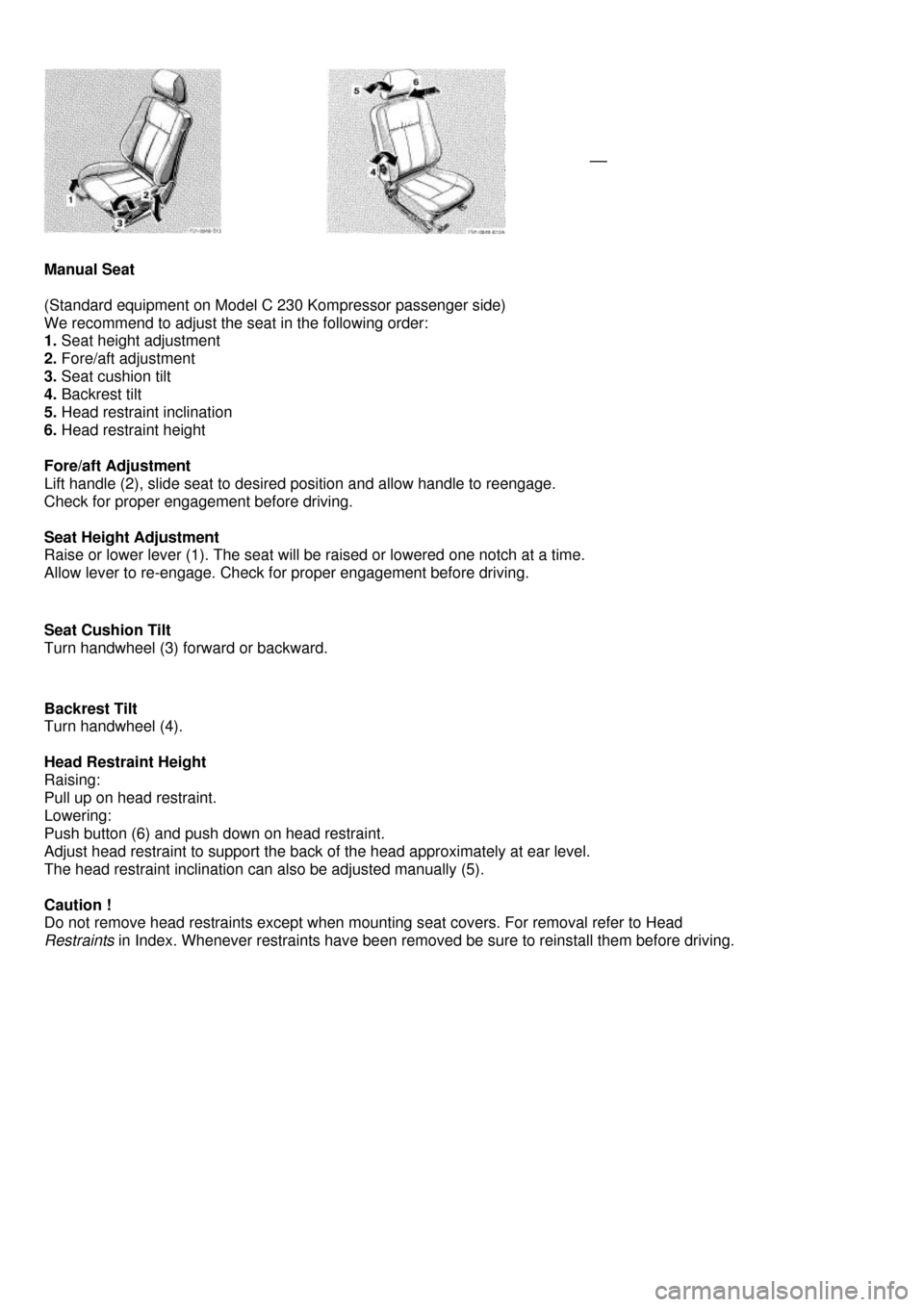
Manual Seat
(Standard equipment on Model C 230 Kompressor passenger side)
We recommend to adjust the seat in the following order:
1. Seat height adjustment
2. Fore/aft adjustment
3. Seat cushion tilt
4. Backrest tilt
5. Head restraint inclination
6. Head restraint height
Fore/aft Adjustment
Lift handle (2), slide seat to desired position and allow handle to reengage.
Check for proper engagement before driving.
Seat Height Adjustment
Raise or lower lever (1). The seat will be raised or lowered one notch at a time.
Allow lever to re-engage. Check for proper engagement before driving.
Seat Cushion Tilt
Turn handwheel (3) forward or backward.
Backrest Tilt
Turn handwheel (4).
Head Restraint Height
Raising:
Pull up on head restraint.
Lowering:
Push button (6) and push down on head restraint.
Adjust head restraint to support the back of the head approximately at ear level.
The head restraint inclination can also be adjusted manually (5).
Caution !
Do not remove head restraints except when mounting seat covers. For removal refer to Head
Restraints in Index. Whenever restraints have been removed be sure to reinstall them before driving.
Page 33 of 130
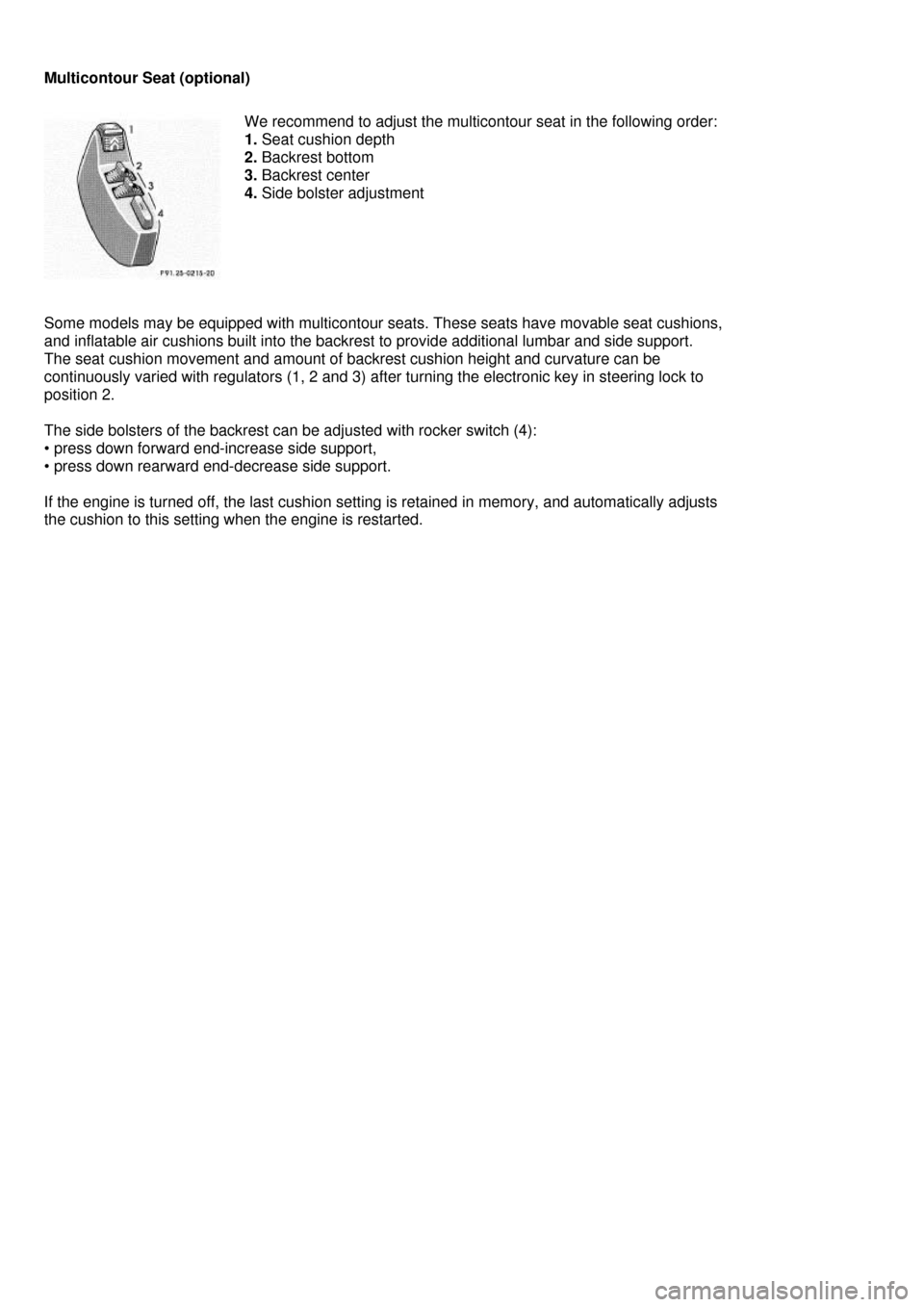
Multicontour Seat (optional)
We recommend to adjust the multicontour seat in the following order:
1. Seat cushion depth
2. Backrest bottom
3. Backrest center
4. Side bolster adjustment
Some models may be equipped with multicontour seats. These seats have movable seat cushions,
and inflatable air cushions built into the backrest to provide additional lumbar and side support.
The seat cushion movement and amount of backrest cushion height and curvature can be
continuously varied with regulators (1, 2 and 3) after turning the electronic key in steering lock to
position 2.
The side bolsters of the backrest can be adjusted with rocker switch (4):
• press down forward end-increase side support,
• press down rearward end-decrease side support.
If the engine is turned off, the last cushion setting is retained in memory, and automatically adjusts
the cushion to this setting when the engine is restarted.
Page 34 of 130

Heated Seats (optional)
Heated Seats (optional)
The front seat heater can be switched on with the electronic key in steering lock
positions 1 or 2.
Press switch to turn on seat heater:
1. Normal seat heating mode. One indicator lamp in the switch lights up.
2. Rapid seat heating mode. Both indicator lamps in the switch light up. After
approximately 5 minutes in the rapid seat heating mode, the seat heater automatically
switches to normal operation and only one indicator lamp will stay on.
Turning off seat heater:
If one indicator lamp is on, press upper half of switch.
If both indicator lamps are on, press lower half of switch.
If left on, the seatheater automatically turns off after approximately 30 minutes of operation.
Note:
When in operation, the seat heater consumes a large amount of electrical power. It is not advisable to use the seat
heater longer than necessary. The seat heaters may automatically switch off if too many power consumers are
switched on at the same time, or if the battery charge is low. When this occurs, the indicator lamp in the switch will
blink (both indicator lamps blink during rapid seat heating mode). The seat heaters will switch on again automatically
as soon as sufficient voltage is available. If the blinking of the indicator lamps is distracting to you, the seat heaters
can be switched off.
Page 35 of 130
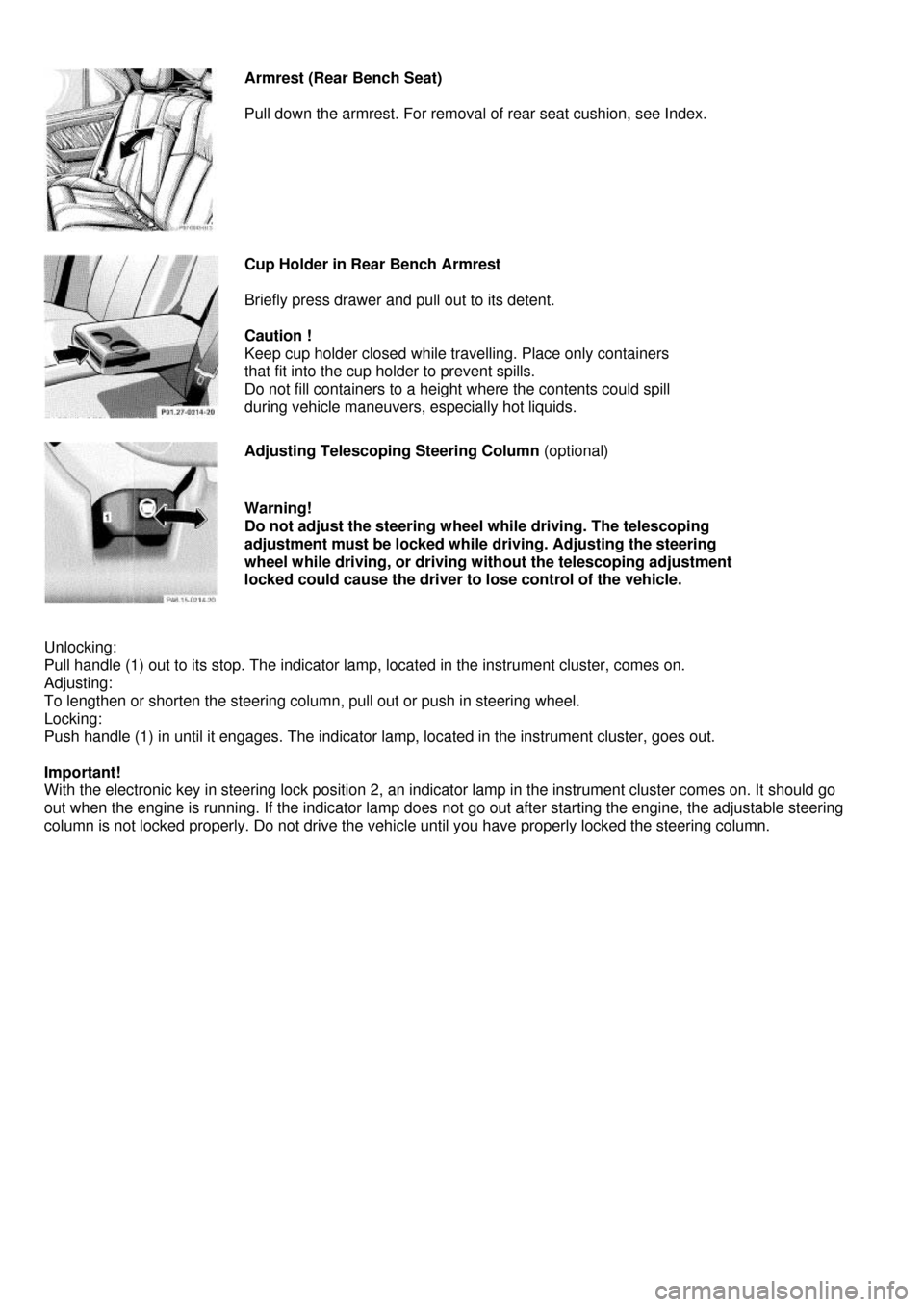
Armrest (Rear Bench Seat)
Pull down the armrest. For removal of rear seat cushion, see Index.
Cup Holder in Rear Bench Armrest
Briefly press drawer and pull out to its detent.
Caution !
Keep cup holder closed while travelling. Place only containers
that fit into the cup holder to prevent spills.
Do not fill containers to a height where the contents could spill
during vehicle maneuvers, especially hot liquids.
Adjusting Telescoping Steering Column (optional)
Warning!
Do not adjust the steering wheel while driving. The telescoping
adjustment must be locked while driving. Adjusting the steering
wheel while driving, or driving without the telescoping adjustment
locked could cause the driver to lose control of the vehicle.
Unlocking:
Pull handle (1) out to its stop. The indicator lamp, located in the instrument cluster, comes on.
Adjusting:
To lengthen or shorten the steering column, pull out or push in steering wheel.
Locking:
Push handle (1) in until it engages. The indicator lamp, located in the instrument cluster, goes out.
Important!
With the electronic key in steering lock position 2, an indicator lamp in the instrument cluster comes on. It should go
out when the engine is running. If the indicator lamp does not go out after starting the engine, the adjustable steering
column is not locked properly. Do not drive the vehicle until you have properly locked the steering column.
Page 36 of 130
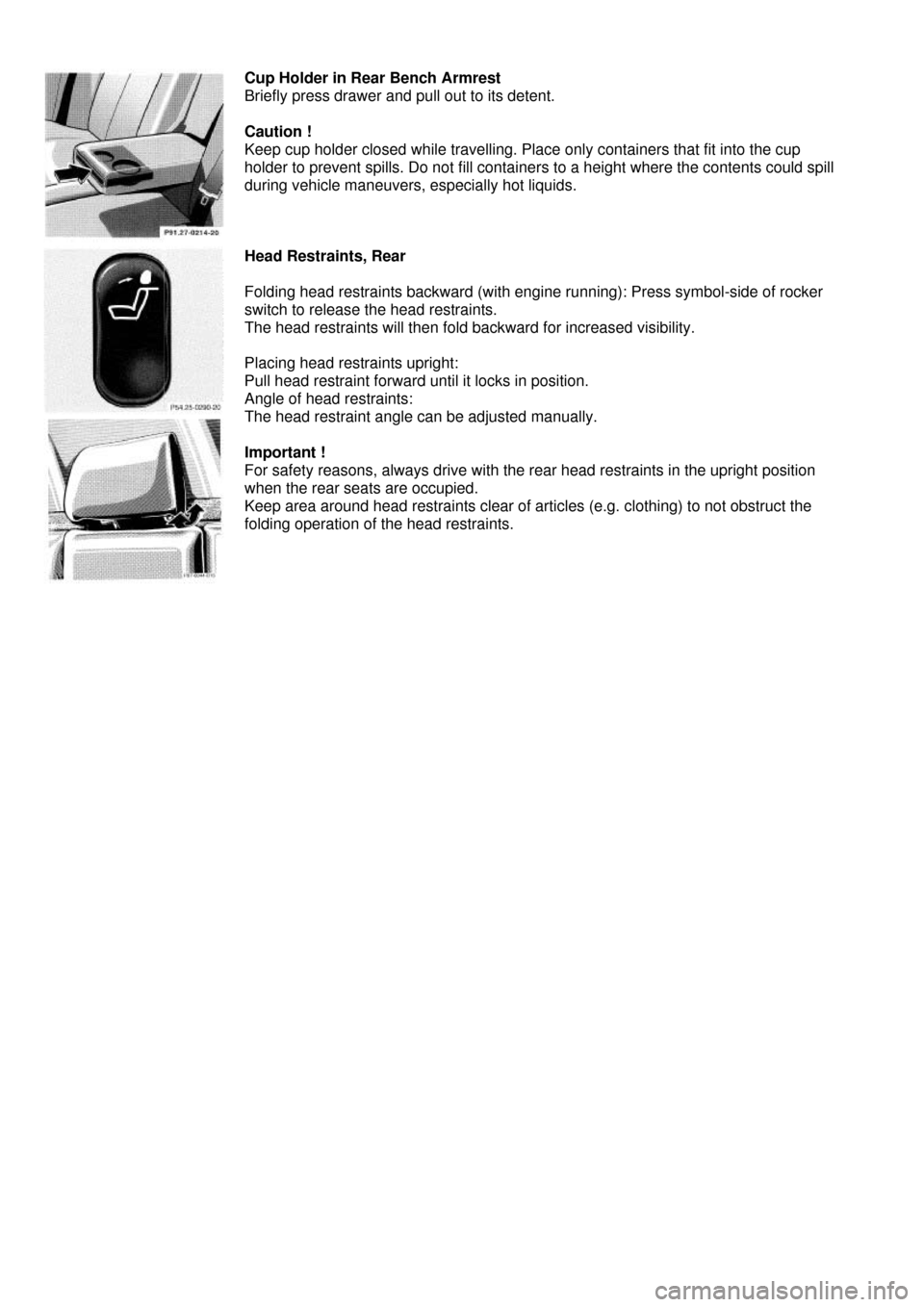
Cup Holder in Rear Bench Armrest
Briefly press drawer and pull out to its detent.
Caution !
Keep cup holder closed while travelling. Place only containers that fit into the cup
holder to prevent spills. Do not fill containers to a height where the contents could spill
during vehicle maneuvers, especially hot liquids.
Head Restraints, Rear
Folding head restraints backward (with engine running): Press symbol-side of rocker
switch to release the head restraints.
The head restraints will then fold backward for increased visibility.
Placing head restraints upright:
Pull head restraint forward until it locks in position.
Angle of head restraints:
The head restraint angle can be adjusted manually.
Important !
For safety reasons, always drive with the rear head restraints in the upright position
when the rear seats are occupied.
Keep area around head restraints clear of articles (e.g. clothing) to not obstruct the
folding operation of the head restraints.
Page 37 of 130

Seat Belts and Supplemental Restraint System (SRS)
Your vehicle is equipped with seat belts for all se ats, emergency tensioning retractors for the front
seats, as well as front and side impact airbag s and knee bolsters for driver and front passenger.
Seat Belts
Important !
Laws in most states and all Canadian provinces require seat belt use. All states and provinces
require use of child restraints that comply with U.S. Federal Motor Vehicle Safety Standard 213 and
Canadian Motor Vehicle Safety Standard 213
All child restraint systems are designed to be secure d in vehicle seats by lap belts or the lap belt
portion of a lap-shoulder belt.
For your safety and that of your pass engers we strongly recommend their use.
Warning !
Children 12 years old and under must never ride in the front seat, except in a Mercedes-Benz
authorized BabySmart™ compatible child seat, which operates with the BabySmart™ system
installed in the vehicle to deactivate the passenger side front airbag when it is properly
installed. Otherwise they will be struck by the airbag when it inflates in a crash. If this
happens, serious or fatal injury will result. The back seat is the safest place for children.
Infants and small children must ride in back seats and be seated in an appropriate infant or
child restraint system, which is properly secured with the vehicle's seat belt, fully in
accordance with the seat manufacturer's instructions. A child's risk of serious or fatal
injuries is significantly increased if the child restraints are not properly secured in the vehicle
and the child is not properly secured in the child restraint.
Warning !
Never ride in a moving vehicle with the seat back reclined. Sitting in an excessively reclined
position can be dangerous. You could slide under the seat belt in a collision. If you slide
under it, the belt would apply force at the abdomen or neck. That could cause serious or even
fatal injuries. The seat back and seat belts provide the best restraint when the wearer is in an
upright position and belts are properly positioned on the body.
Seat Belt Warning System
With the electronic key in steering lock position 2, a warning sounds for a short time if the driver's
seat belt is not fastened.
Warning !
Failure to wear and properly fasten and position your seat belt greatly increases your risk of
injuries and their likely severity in an accident. You and your passengers should always wear
seat belts.
If you are ever in an accident, your injuries can be considerably more severe without your
seat belt properly buckled. Without your seat belt buckled, you are much more likely
to hit the interior of the vehicle or be ejected from it. You can be seriously injured or killed.
In the same crash, the possibility for injury or death is lessened with your seat belt
buckled.
Page 38 of 130
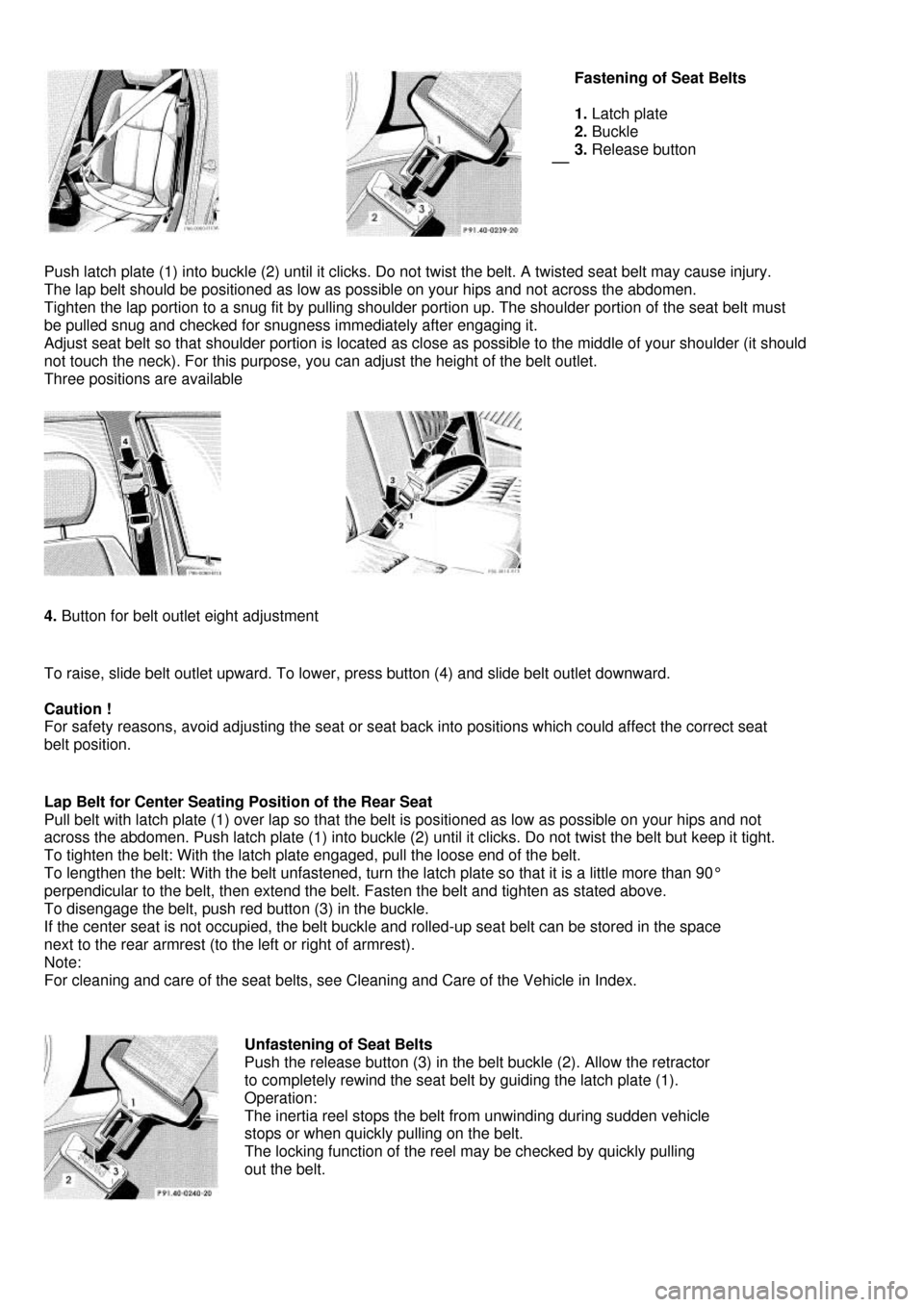
Fastening of Seat Belts
1. Latch plate
2. Buckle
3. Release button
Push latch plate (1) into buckle (2) until it clicks. Do not twist the belt. A twisted seat belt may cause injury.
The lap belt should be positioned as low as possible on your hips and not across the abdomen.
Tighten the lap portion to a snug fit by pulling shoulder portion up. The shoulder portion of the seat belt must
be pulled snug and checked for snugness immediately after engaging it.
Adjust seat belt so that shoulder portion is located as close as possible to the middle of your shoulder (it should
not touch the neck). For this purpose, you can adjust the height of the belt outlet.
Three positions are available
4. Button for belt outlet eight adjustment
To raise, slide belt outlet upward. To lower, press button (4) and slide belt outlet downward.
Caution !
For safety reasons, avoid adjusting the seat or seat back into positions which could affect the correct seat
belt position.
Lap Belt for Center Seating Position of the Rear Seat
Pull belt with latch plate (1) over lap so that the belt is positioned as low as possible on your hips and not
across the abdomen. Push latch plate (1) into buckle (2) until it clicks. Do not twist the belt but keep it tight.
To tighten the belt: With the latch plate engaged, pull the loose end of the belt.
To lengthen the belt: With the belt unfastened, turn the latch plate so that it is a little more than 90°
perpendicular to the belt, then extend the belt. Fasten the belt and tighten as stated above.
To disengage the belt, push red button (3) in the buckle.
If the center seat is not occupied, the belt buckle and rolled-up seat belt can be stored in the space
next to the rear armrest (to the left or right of armrest).
Note:
For cleaning and care of the seat belts, see Cleaning and Care of the Vehicle in Index.
Unfastening of Seat Belts
Push the release button (3) in the belt buckle (2). Allow the retractor
to completely rewind the seat belt by guiding the latch plate (1).
Operation:
The inertia reel stops the belt from unwinding during sudden vehicle
stops or when quickly pulling on the belt.
The locking function of the reel may be checked by quickly pulling
out the belt.
Page 39 of 130

Warning !
USE SEAT BELTS PROPERLY.
• Each occupant should wear their seat belt at all times, because seat belts help reduce the
likelihood of and potential severity of injuries in accidents, including rollovers. "SRS" (driver
airbag, front passenger airbag, front door side impact airbags), "ETR" (seat belt emergency
tensioning retractors), and knee bolsters are impacts which exceed preset deployment thresholds.
• Improperly positioned seat belts do not provide maximum protection and may
cause serious injuries in case of an accident.
• Never wear the shoulder belt under your arm, against your neck or off your shoulder. In a
crash, your body would move too far forward. That would increase the chance of head and
neck injuries. The belt would also apply too much force to the ribs or abdomen, which could
severely injure infernal organs such as your liver or spleen.
• Position the lap belt as low as possible on your hips and not across the abdomen. If the
belt is positioned across your abdomen, it could cause serious injuries in a crash.
• Each seat belt should never be used for more than one person at a time. Do not fasten a
seat belt around a person and objects.
• Belts should not be worn twisted. In a crash, you wouldn't have the full width of the belt to
manage impact forces. The twisted belt against your body could cause injuries.
• Pregnant women should also use a lap-shoulder belt. The lap belt portion should be positioned
as low as possible on the hips to avoid any possible pressure on the abdomen.
Warning !
USE CHILD RESTRA INTS PROPERLY.
Children 12 years old and under must never ride in the front seat, except in a Mercedes-Benz
authorized Baby Smart™ compatible child seat, which operates with the BabySmart™ system
installed in the vehicle to deactivate the passenger side front airbag when it is properly installed.
Otherwise they will be struck by the airbag when it inflates in a crash. If this happens, serious or
fatal injury will result.
According to accident statistics, children are safer when properly restrained in the rear seating
positions than in the front seating positions. Infants and small children must ride in back seats
and be seated in an appropriate infant or child restraint system, which is properly secured with
the vehicle's seat belt, fully in accordance with the seat manufacturer's instructions.
A child's risk of serious or fatal injuries is signi ficantly increased if the child restraints are not
properly secured in the vehicle and the child is not properly secured in the child restraint.
Children too big for child restraint systems must ride in back seats using regular seat belts.
Position shoulder belt across chest and shoulder, not face or neck. A booster seat may be
necessary to achieve proper belt positioning.
Page 40 of 130

BabySmart™ Airbag Deactivation System
Special child seats, designed for use with the Mercedes-Benz system and available at any
authorized Mercedes-Benz dealer are required for use with the BabySmart™ airbag deactivation
system. With the special child seat properly installed, the passenger front airbag will not deploy. The
indicator lamp located on the center console will be illuminated, except with electronic key
removed or in steering lock position 0. The system does not deactivate the door mounted side
impact airbag.
BabySmart is a trademark of Siemens Automotive Corp.
Warning !
The BabySmart™ Airbag Deactivation System will ONLY work with a special seat designed to
operate with it. It will not work with seats which are not BabySmart™ compatible. Never place
anything between seat cushion and child seat (e.g. pillow), since it reduces the effectiveness
of the deactivation system. Follow the manufacturer's instructions for installation of special
child seats. The passenger side front airbag will not deploy only if the indicator lamp
remains illuminated. Please be sure to check the indicator every time you use the special
system child seat. Should the light go out while the restraint is installed, please check
installation. If the light remains out, do not use the BabySmart™ restraint to transport
children, on the front passenger seat until the system has been repaired.
Self-Test BabySmart™ Without Special Child Seat Installed
After turning electronic key in steering lock to position 1 or 2, the indicator lamp located on
center console comes on for approx. 6 seconds.
If the lamp should not come on or is continuously lit, the system is not functioning. You must see an
authorized Mercedes-Benz dealer before using any child seat on the front passenger seat.